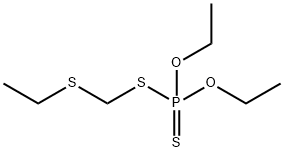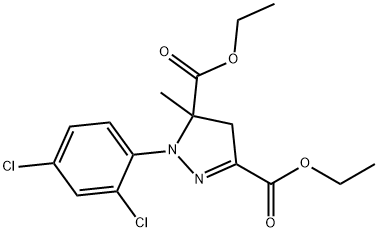Phorate
Synonym(s):O,O-Diethyl S-(ethylthiomethyl) phosphorodithioate
- CAS NO.:298-02-2
- Empirical Formula: C7H17O2PS3
- Molecular Weight: 260.38
- MDL number: MFCD00036348
- EINECS: 206-052-2
- SAFETY DATA SHEET (SDS)
- Update Date: 2025-01-27 09:38:02

What is Phorate?
Description
Phorate is a colorless oil. The water solubility is 50 mg/L (25 ?C). It is miscible with common organic solvents. Log Kow = 3.92. Phorate is relatively unstable to hydrolysis in aqueous media; DT50 values at pH 7 and 9 are 3.2 and 3.9 d, respectively. Phorate is effective against sucking plant pests as a systemic insecticide-acaricide and also has good contact and vapor actions. It is usually formulated as granules. The acute oral LD50 for rats is 1.6–3.7 mg/kg. Inhalation LC50 (1 h) for rats is 0.06–0.011 mg/L air. ADI is 0.5 μg/kg b.w.
Chemical properties
Phorate is a clear mobile liquid with a skunk-like odor
The Uses of Phorate
Phorate is a non-biocumulative organophosphate used as an insecticide and acaricide. Phorate is an inhibitor of acetylcholinesterase and pseudocholinesterase.
The Uses of Phorate
Insecticide.
The Uses of Phorate
Systemic insecticide for control of mites, chewing and sucking insects in fruits and vegetables, cotton and some ornamentals
The Uses of Phorate
Phorate is a systemic insecticide used to control sucking and chewing pests in a very wide range of crops. It is also active as a nematicide and has some vapour phase activity.
Definition
ChEBI: Phorate is an organic thiophosphate and an organothiophosphate insecticide. It has a role as an EC 3.1.1.7 (acetylcholinesterase) inhibitor, an EC 3.1.1.8 (cholinesterase) inhibitor, an acaricide and an agrochemical. It is functionally related to an (ethylsulfanyl)methanethiol.
General Description
Clear liquid with an objectionable odor. Used as an insecticide and acaricide; Phorate is applied to plants and soil.
Air & Water Reactions
Phorate is incompatible with the following: Water, alkalis [Note: Hydrolyzed in the presence of moisture and by alkalis.] .
Reactivity Profile
Organothiophosphates, such as Phorate, are susceptible to formation of highly toxic and flammable phosphine gas in the presence of strong reducing agents such as hydrides. Partial oxidation by oxidizing agents may result in the release of toxic phosphorus oxides.
Health Hazard
Phorate is one of the more toxic organophosphorus insecticides. It is a cholinesterase inhibitor that acts on the nervous system, and produces toxicity similar to Parathion. The probable oral lethal dose for humans is less than 5 mg/kg, i.e. a taste (less than 7 drops) for a 70 kg (150 lb.) person.
Fire Hazard
Shock can shatter containers, releasing the contents. When heated to decomposition, toxic fumes of sulfur oxides, phosphorus oxides, and nitrogen oxides are emitted. Hydrolyzed in water and alkalies.
Agricultural Uses
Insecticide, Acaricide, Nematicide: Phorate is an organophosphorus insecticide and acaricide used to control a wide variety of sucking and chewing insects, leafhoppers, leafminers, mites, somenematodes, and rootworms. It is used on many crops, including root and field crops such as corn, cotton, coffee, potatoes, sugar beets, beans, peanuts, wheat, some ornamental and herbaceous plants, and bulb. In the U.S., 80% of the annual use of phorate is applied to corn, potatoes and cotton. It is available in granular and emulsifiable concentrate formulations. Phorate has been shown to be responsible for a large number of bird kills and it is extremely toxic to mammals. Not approved for use in EU countries. A U.S. EPA restricted Use Pesticide (RUP). U.S. Maximum Allowable Residue Levels for Phorate (40 CFR 180.206): bean 0.1 ppm; beet, sugar, roots 0.3 ppm; beet, sugar, tops 3 ppm; coffee, bean 0.02 ppm; corn, forage 0.5 ppm; corn, grain 0.1 ppm; corn, sweet, kernel plus 0.1 ppm; cob with husks removed ppm; cotton, undelinted seed 0.05 ppm; hop 0.5 ppm; peanut 0.1 ppm; potato 0.5 ppm; sorghum, grain, grain 0.1 ppm; sorghum, grain, stover 0.1 ppm; soybean 0.1 ppm; sugarcane, cane 0.1 ppm; wheat, grain 0.05 ppm; wheat, hay 1.5 ppm; wheat, straw 0.05 ppm.
Trade name
AASTAR®[C]; AC 3911®; AGRIMET®; AMERICAN CYANAMID 3,911®; EL 3911®; EXPERIMENTAL INSECTICIDE 3911®; GEOMET®; GRAMTOX®; GRANUTOX®; L 11/6®; METAPHOR®; PHORATE-10G®; PHORIL®; RAMPART®; TERRACLOR®; TERRATHION GRANULES®; THIMENOX®; THIMET®; THEMET®; UMET®; VEGFRU®; VERGFRU FORATOX®
Safety Profile
Poison by ingestion and sh contact routes. Experimental reproductive effects. Mutation data reported. A cholinesterase irhbitor. When heated to decomposition it emits toxic fumes of POx and SOx. See also PARATHION
Potential Exposure
Those engaged in the manufacture, formulation and application of this systemic and contact insecticide and acaricide. It is also used as a soil insecticide.
Carcinogenicity
When dogs were given phorate
via capsules at doses of 0.005, 0.01, 0.05, or 0.25 mg/kg/day
for 1 year, slight body tremors, marginal inhibition of body
weight gain, and RBC and brain cholinesterase inhibition
occurred in males given 0.25 mg/kg/day .
No evidence of carcinogenicity occurred in rats given
diets that contained 0, 1, 3, or 6 ppm phorate (equal to about
0, 0.05, 0.15, or 0.3 mg/kg/day) for 2 years .
Erythrocyte and brain cholinesterase inhibition occurred at
exposures of 3 and 6 ppm. No evidence of carcinogenicity
or other adverse effects occurred in mice given diets that
contained 0, 1, 3, or 6 ppm phorate (equal to about 0, 0.15,
0.45, and 0.9 mg/kg/day) for 78 weeks, other than a slight
decrease in body weight gain in females that were fed
6 ppm .
Environmental Fate
Biological. [14C]Phorate degraded in a model ecosystem consisting of soil, plants and
water (Lichtenstein et al., 1974). Under both non-percolating and percolating water conditions, 12% of the applied amount migrated downward as the corresponding sulfone and
sulfoxide. Phorate was absorbed in the roots of corn and was transformed primarily to the
sulfone with trace amounts of the sulfoxide. Translocation of radioactive insecticide to
the leaves was also observed but the major products were identified as phoratoxon sulfone
and phoratoxon sulfoxide (Lichtenstein et al., 1974)
From the first-order biotic and abiotic rate constants of phorate in estuarine water and
sediment/water systems, the estimated biodegradation half-lives were 1.1–1.6 and 0.7–1.6
days, respectively (Walker et al., 1988)
Soil. The corresponding sulfoxide and sulfone and their phosphorothioate analogs are
major soil metabolites (Lichtenstein et al., 1974). The phosphorothioate analogs may
hydrolyze forming dithio-, thio- and orthophosphoric acids (Hartley and Kidd
Phorate was moderately persistent in soil. Way and Scopes (1968) reported residues
comprised 10% of applied dosage 540 days after application. The reported half-life in soil
is 82 days (Jury et al., 1987) and 68 days in a sandy soil (Way and Scopes, 1968). The
half-lives for phorate in soil incubated in the laboratory under aerobic conditions ranged
from 7 to 82.5 days with an average half-life of 75 days (Getzin and Chapman, 1960;
Getzin and Shark, 1970). Approximately three days after applying phorate to a sandy soil,
41% was lost to volatilization (Burns, 1971)
Plant. Oat plants were grown in two soils treated with [14C]phorate. Most of the
residues remained bound to the soil. Less than 2% of the applied [14C]phorate was
recovered from the oat leaves. The major residues in soil were phorate and the corr
Metabolic pathway
Phorate is metabolised by an analogous route to that of disulfoton. The principal route of phorate metabolism in all media is activation via oxidation of the thioether group to the sulfoxide (rapid) and sulfone (slower). Thioether oxidation occurs preferentially to oxidative desulfuration of the P=S group to the oxon, which is usually only present in trace amounts, and there is good evidence that the sulfoxide and sulfone oxons arise via phorate sulfoxide and sulfone rather than phorate oxon. The more polar thiooxidised metabolites are translocated in plants and are responsible for the compound’s systemic action. Of all phorate’s metabolites, phorate oxon sulfone is the most active inhibitor of acetylcholinesterase (Bowman and Casida, 1957). Degradative metabolism occurs via oxidative dealkylation of the phosphorodithioate group or hydrolysis of the oxon.
Metabolism
The metabolic routes of phorate are essentially the same in plants, animals, and soils, involving the oxidation of the sulfide group into the sulfoxide then sulfone, and oxidative desulfuration to the corresponding oxons, followed by hydrolysis to diethyl hydrogen phosphorodithioate, phosphorothioate, and phosphate. Phorate protects plants for a relatively long time because of the persistency of the sulfoxide metabolite in plants and in soils. DT50 in soil is 2–14 d.
Shipping
UN3018 Organophosphorus pesticides, liquid, toxic, Hazard Class: 6.1; Labels: 6.1-Poisonous materials. UN2783 Organophosphorus pesticides, solid, toxic, Hazard Class: 6.1; Labels: 6.1-Poisonous material. UN2810 Toxic liquids, organic, n.o.s., Hazard Class: 6.1; Labels: 6.1-Poisonous materials, Technical Name Required.
Degradation
Phorate in aqueous solution is hydrolysed and degraded by light. The half-lives at pH 7 and 9 were 3.2 and 3.9 days, respectively (PM). When exposed to sunlight or UV light phorate was apparently oxidised to products which were more active inhibitors of acetylcholinesterase than phorate or its sulfoxide (Bowman and Casida, 1957). Although not specifically identified these photolysis products were likely to be the thiooxidised phorate oxon.
Incompatibilities
Water, alkalis. Hydrolyzed in the presence of moisture and by alkalis; may produce toxic oxides of phosphorus and sulfur. Strong oxidizers may cause release of toxic phosphorus oxides. Organophosphates, in the presence of strong reducing agents such as hydrides, may form highly toxic and flammable phosphine gas. Keep away from alkaline materials.
Waste Disposal
In accordance with 40CFR165, follow recommendations for the disposal of pesticides and pesticide containers. Must be disposed properly by following package label directions or by contacting your local or federal environmental control agency, or by contacting your regional EPA office. Consult with environmental regulatory agencies for guidance on acceptable disposal practices. Generators of waste containing this contaminant (≥100 kg/mo) must conform with EPA regulations governing storage, transportation, treatment, and waste disposal.
Properties of Phorate
| Melting point: | -43°C |
| Boiling point: | 125-127°C (2 mmHg) |
| Density | d425 1.156 |
| vapor pressure | 8.5×10-2 Pa (25 °C) |
| refractive index | nD25 1.5329 |
| storage temp. | 0-6°C |
| solubility | Chloroform (Slightly), Ethyl Acetate (Slightly), Methanol (Slightly) |
| form | neat |
| Water Solubility | 0.005 g/100 mL |
| BRN | 1708517 |
| Exposure limits | ACGIH TLV: TWA 0.05 mg/m3 ppm, STEL 0.2 mg/m3 |
| Stability: | Stable. Incompatible with strong oxidizing agents. |
| CAS DataBase Reference | 298-02-2(CAS DataBase Reference) |
| NIST Chemistry Reference | Phorate(298-02-2) |
| EPA Substance Registry System | Phorate (298-02-2) |
Safety information for Phorate
| Signal word | Danger |
| Pictogram(s) |
 Skull and Crossbones Acute Toxicity GHS06  Environment GHS09 |
| GHS Hazard Statements |
H410:Hazardous to the aquatic environment, long-term hazard |
| Precautionary Statement Codes |
P260:Do not breathe dust/fume/gas/mist/vapours/spray. P262:Do not get in eyes, on skin, or on clothing. P273:Avoid release to the environment. P280:Wear protective gloves/protective clothing/eye protection/face protection. |
Computed Descriptors for Phorate
New Products
4,4-Difluoropiperidine hydrochloride tert-butyl 9-methoxy-3-azaspiro[5.5]undecane-3-carboxylate Indole Methyl Resin N-Isopropylurea N,N-Dicyclohexylcarbodiimide(DCC) MELDRUMS ACID 5-METHYLISOXAZOLE-4-CARBOXYLIC ACID Magnessium Bis glycinate Zinc ascorbate 1-bromo-2-butyne 2-acetamidophenol 9(10H)-anthracenone Erythrosin B, 4-Piperidinopiperidine 2-((4-morpholinophenylamino) (methylthio) methylene) malononitrile 2,4-dihydroxybenzaldehyde 3-(4-morpholinophenylamino)-5-amino-1H-pyrazole-4-carbonitrile Methyl 2-methylquinoline-6-carboxylate 2,6-dichloro-4-nitropyridine 4-Bromo-2-chlorobenzonitrile 2-(benzylamino)acetic acid hydrochloride 4-(tert-Butoxycarbonylamino)but- 2-ynoic acid 3,4-dihydro-2H-benzo[b][1,4]dioxepine 1-Phenyl-1-cycloprppanecarboxylicacidRelated products of tetrahydrofuran








You may like
-
 3-(4-amino-1-oxoisoindolin-2-yl)-1-methylpiperidine-2,6-dione 98%View Details
3-(4-amino-1-oxoisoindolin-2-yl)-1-methylpiperidine-2,6-dione 98%View Details -
 1-methylindoline-2,3-dione 98%View Details
1-methylindoline-2,3-dione 98%View Details
2058-74-4 -
 614-19-7 98%View Details
614-19-7 98%View Details
614-19-7 -
 3112-85-4 Methyl phenyl sulfone 98%View Details
3112-85-4 Methyl phenyl sulfone 98%View Details
3112-85-4 -
 20677-73-0 (2,2-diethoxyethyl)methylamine 98%View Details
20677-73-0 (2,2-diethoxyethyl)methylamine 98%View Details
20677-73-0 -
 3-(4-(hydroxyamino)-1-oxoisoindolin-2-yl)piperidine-2,6-dione 98%View Details
3-(4-(hydroxyamino)-1-oxoisoindolin-2-yl)piperidine-2,6-dione 98%View Details -
 57381-49-4 2-bromo-4-chlorobenzonitrile 98%View Details
57381-49-4 2-bromo-4-chlorobenzonitrile 98%View Details
57381-49-4 -
 4,6-dichloropyrimidine-5-carbaldehyde 98%View Details
4,6-dichloropyrimidine-5-carbaldehyde 98%View Details
5305-40-8
